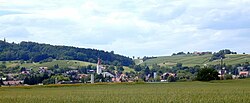Klettgau is located on the Klingengraben and Schwarzbach creeks. In the east it borders on the Swiss municipalities of Trasadingen, Wilchingen and Wasterkingen. The neighbouring German municipalities are Wutöschingen, Lauchringen, Küssaberg, and Hohentengen am Hochrhein in the west, as well as Dettighofen in the east. There is a border crossing into Switzerland on the road from Erzingen to Trasadingen.
The municipal area comprises the villages of Bühl, Erzingen, Geißlingen, Grießen, Rechberg, Riedern am Sand, and Weisweil. Erzingen, Bühl and Riedern am Sand are part of the Baden wine region.
The Habsburgs began to rule over the County of Klettgau when Radbot most likely inherited it, he ended up reigning over Klettgau from 991-1045, he was then succeeded by his son;
Werner I who reigned over Klettgau from 1045 to 1096.
Otto II reigned over it after his father died, later he was the first person to become a count of Habsburg, he ruled Klettgau from 1096 to 1111. His son Werner II, who ruled over Klettgau from 1111 to 1167 would inherit. Werner was succeeded by Albert 'the Rich', (1167-1199) he was succeeded by Rudolf II. (1199-1232) He was then succeeded by Albert IV (1232-1239) Albert was then succeeded by the soon-to-be King of Germany; Rudolf I Before becoming king, Rudolf was titled Rudolf IV, Count of Habsburg. However he would not stay a count, Rudolf was later elected king of the Germans in 1273 Rudolf later died in 1291. Rudolf Was Succeeded by his son; Albert I (1291-1308) who'd soon after inheriting the land of Klettgau from his father would become king of Germany. His son Albert II became the first Habsburg Duke of Austria (1308-1358) His Successor Rudolf IV (1358-1386) Inherited the title of Klettgau, Albert, II's son Leopold III (1365-1386) Inherited Rudolf's titles after his death in 1365. Later during his reign he lost Klettgau and other Swiss holdings, as well as his life in the Battle of Sempach which took place in 1386. The death of Leopold, III was followed by Switzerland taking all of his holdings in the region including Klettgau, but later the Swiss agreed to give the lands north of the modern Swiss border to the Habsburgs during the treaty. but Klettgau was under Swiss Influence so this is counted as the end.
Population development:[3]
More information Year, Inhabitants ...
| Year |
Inhabitants |
|---|
| 2015 |
7,414 |
| 2016 |
7,430 |
| 2017 |
7,573 |
| 2018 |
7,569 |
| 2019 |
7,578 |
| 2020 |
7,669 |
|
Close
![[icon]](//upload.wikimedia.org/wikipedia/commons/thumb/1/1c/Wiki_letter_w_cropped.svg/20px-Wiki_letter_w_cropped.svg.png) | This section needs expansion. You can help by adding to it. (February 2023) |
Railway station
Klettgau has a railway station located very close to the border with Switzerland, in Erzingen. The station building was completed in 1863.
The railway line from Erzingen to Schaffhausen was electrified and tracks along almost the entire route were doubled, allowing for more frequent services to run. The electrification of the line from Erzingen to Waldshut as well as from Waldshut on to Basel Badischer Bahnhof has also been agreed on and is planned.[4][5]
The station is a border station and as such is in local transport tariff zones in both Germany and Switzerland.
Customs
Erzingen is, for customs purposes, a border station for passengers arriving from Switzerland. Customs checks may be performed in Erzingen station or on board trains by German officials. Systematic passport controls were abolished when Switzerland joined the Schengen Area in 2008.[6][7]




